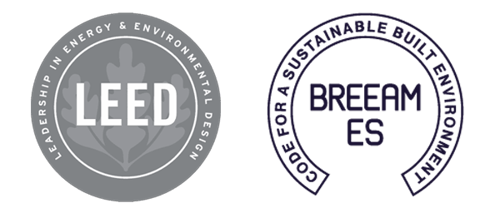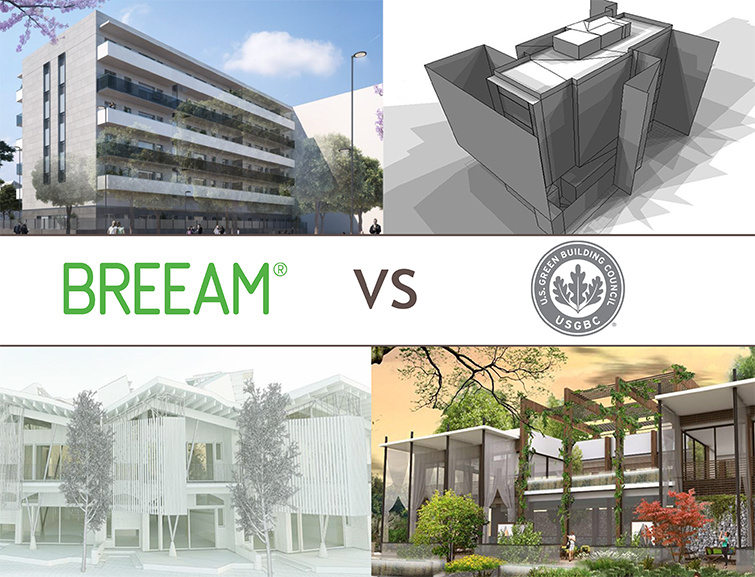As we saw in the first part of the comparison of LEED and BREEAM sustainable certifications, there are several differences between these two certification schemes, and the choice of one or the other will depend on the characteristics of the project.
As we saw in the first part of the comparison, the two most internationally recognised and widespread sustainable certificates are LEED (Leadership in Energy and Environmental Design) and BREEAM (Building Research Establishment's Environmental Assessment Method). Despite having different origins and characteristics, both have become almost mandatory certificates for most large-scale real estate transactions. Let's see what the keys to each one are.

Different methodologies depending on the type of operation
To begin with, it should be understood that both BREEAM and LEED have different methodologies for assessing the sustainability of buildings depending on the type of operation. It is not the same to certify a building in use, where the only goal is to add value to the asset, as it is to certify another that has just been acquired for complete renovation. Therefore, both certifications have specific tools depending on the case.
On the one hand, the methodologies developed for new buildings or major renovations focus primarily on the design and construction of the same, leaving very little room to evaluate the building use. In the case of LEED it's called Building Design and Construction (LEED BD+C) while in BREEAM it is called New Construction (BREEAM NC).
On the other hand, the tools focused on buildings in use are based on an assessment of the building, but above all they emphasise its management and maintenance and are called LEED Operations and Maintenance (LEED O+M) and in the case of BREEAM, it is called BREEAM in Use.
This article will focus solely on applications for new buildings or major renovations: LEED BD+C vs BREEAM NC. Let's look at the main differences in the application of both.
The previous design
Both tools value having a multidisciplinary team from the beginning of the project, which also includes the certifier team and the property, to establish sustainability objectives and study different strategies to achieve them. In this way, it is possible to achieve better results in terms of the building's sustainability and to take advantage of opportunities that may arise during the start of the project, which can reduce the initial budget and save resources. The involvement of the property in this process favours important decision-making from the beginning of the project, evaluating aspects such as: energy, user comfort, office design, work environment, maintenance, etc.

In both certification systems, the integrated design process is presented as the first credit and is equivalent to one point. In the case of LEED, it is a single section, while in BREEAM it is part of the Sustainable Management section, a much more extensive section that addresses other aspects such as the impacts of construction areas or the commissioning of facilities. Aspect, the latter of which LEED addresses in the Energy section.
Site Selection
Both certifications notably favour the selection of sites located in developed areas and therefore have good connectivity with public transportation and surrounding services. In addition, LEED rewards considerably the rehabilitation of existing buildings, as it considers the Carbon Footprint associated with a rehabilitation project to be much lower than that of a new building. Therefore, by thoroughly studying the location of the project, in the case of LEED, up to 11 points can be achieved for new buildings, and up to 16 for rehabilitated buildings, while in BREEAM, 8% of the total available points can be achieved by choosing the site well.
Depending on the location, between 8% and 12% of starting points can be obtained without any additional effort.
Conservation of the environment
The conservation of the environment refers to keeping the environmental conditions prior to the building construction intact. This is obviously impossible, but by applying certain measures, this impact can be reduced. In LEED we find all requirements on this topic under "Sustainable Plot", while BREEAM calls its section "Land Use and Ecology". The first one is quite extensive as it deals with aspects such as light pollution, rainwater management, the creation of green spaces, etc. While BREEAM addresses the impact on the environment also within other sections such as: Pollution, Health and Well-being, and Water.
The main differences lie in the need for BREEAM certification to have an ecologist involved in the process from the beginning if a high score is to be achieved. On the other hand, in LEED it is not necessary to have a specialist technician for this work, allowing the work team to freely choose the measures it deems appropriate, as long as they are technically supported.
LEED also addresses some aspects overlooked by BREEAM, such as the heat island effect, which should be combated with large white or reflective surfaces, green roofs, or solar panels. It also awards up to two points for having a minimum of open spaces, 25% of which must be green areas.
Transport
Reducing the use of private vehicles and opting for alternative means of transportation is a common goal of all sustainability tools. LEED has specific credits related to electric mobility, the reduction of parking spaces, or proximity to bike lanes. Meanwhile, BREEAM has an exclusive section for transport, which also values other alternative transport methods such as car sharing, and also rewards the development of a specific mobility plan for the project.

Charging point for electric cars in a store with BREEAM certification
Health and wellness
LEED, since its last revision in 2016 (LEED V4), has placed building users in a prominent position, giving much more importance to the health and occupant comfort. To this end, LEED evaluates aspects such as: thermal comfort, air quality, increased air renewals, exterior views, natural lighting, the lighting comfort of artificial light, acoustics, glare, etc. Many of these measures were already incorporated in BREEAM without significant differences in general between both tools, except for LEED's requirements regarding natural lighting and glare, which have made it very difficult to obtain credits in that section.

Example of lighting study for offices
Energy
One of the fundamental aspects in every sustainable building is energy savings and the use of renewable energies. In both certifications, this aspect accounts for around 20% of the total.
Despite this coincidence, it is in the energy section where one of the fundamental differences between the two certifications appears: while LEED uses energy simulation tools of recognised prestige such as Energy Plus, BREEAM opts for the HULC programme, which is endorsed by the government.
LEED uses internationally recognised energy simulation tools such as Energy Plus. On the other hand, BREEAM opts for simulation tools in accordance with the regulations of each country.
The methodology used by LEED to justify the calculation of energy savings is much more rigorous, and therefore the results are more credible.
Finally, this section also highlights the importance of the supervision of the commissioning of the facilities, known as the Commissioning process, which is a LEED prerequisite whereas it is not mandatory in BREEAM.
Water
In reference to water, external and internal demand is calculated, alternatives to reduce its consumption are evaluated, and efforts are made to improve its quality. The two sustainable labels are quite similar, although it is worth highlighting the effort made by both to adapt them to our country, where a large part of the territory is characterised by droughts. In the case of LEED, water use reduction allows for the acquisition of two regional points, while in BREEAM, credits have been incorporated that take into account the prevention of leaks and water escapes.
Materials
The choice of materials is a complex issue that is approached from different points of view: environmental impact, impact on people's health, performance, origin, responsible manufacturing methods, etc. Both tools address all these aspects through various very similar credits. However, there are certain differences that can be summarized in these points:
- Rehabilitated buildings: LEED values building retrofitting by awarding up to 6 points directly without any calculation. BREEAM, on the other hand, barely takes into account that the retrofitted parts of a building reduce the impact of the life cycle, as they avoid the use of new materials.
- Responsible Manufacturing: BREEAM takes into account the responsible manufacturing process of products, beyond wood, valuing that manufacturing companies have ISO14001.
- Origin of the materials: LEED values the distance to the origin of the products, while BREEAM considers it to a lesser extent in the evaluation section of the life cycle analysis.
As can be seen, both tools pose significant challenges to the market, ranging from product manufacturers to users, encompassing the entire design and construction process. Although they are very similar, they have important differences; therefore, it is highly recommended to have the expert advice of independent consultants who serve as guides and provide orientation in decision-making from the beginning of the project. You can consult our portfolio of BREEAM and LEED projects to get an idea of the type of projects that can be certified with each tool.


